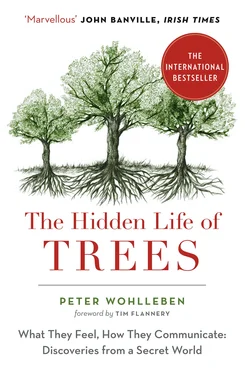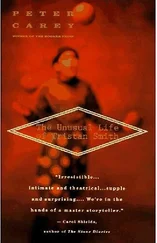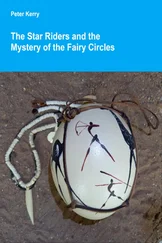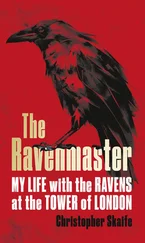Conifers bloom almost every year, which means bees are an option for pollination because they would always find food. However, conifers are native to northern forests, which are too chilly for bees to be out and about while the trees are blooming, and that is probably why conifers, like beeches and oaks, prefer to rely on the wind. Conifers don’t need to worry about taking breaks from blooming, like beeches or oaks, because they have no reason to fear deer and wild boar. The small seeds inside the cones of Spruce & Co. just don’t offer an attractive source of nutrition. True, there are birds such as red crossbills, which pick off cones with the tips of their powerful crossed bills and eat the seeds inside, but in general, birds don’t seem to be a big problem. And because there is almost no animal that likes to store conifer seeds for winter food, the trees release their potential heirs into the world on tiny wings. Thus equipped, their seeds float slowly down from the tips of their branches and can easily be carried away on a breath of wind.
Spruce & Co. produce huge quantities of pollen, almost as though they wanted to outdo deciduous trees in the mating department. They produce such huge quantities that even in a light breeze, enormous dusty clouds billow over coniferous forests in bloom, giving the impression of a fire smoldering beneath the treetops. This raises the inevitable question about how inbreeding can be avoided in such chaotic conditions. Trees have survived until today only because there is a great deal of genetic diversity within each species. If they all release their pollen at the same time, then the tiny grains of pollen from all the trees mix together and drift through the canopy. And because a tree’s own pollen is particularly concentrated around its own branches, there’s a real danger its pollen will end up fertilizing its own female flowers. But, as I just mentioned, that is precisely what the trees want to avoid. To reduce this possibility, trees have come up with a number of different strategies.
Some species—like spruce—rely on timing. Male and female blossoms open a few days apart so that, most of the time, the latter will be dusted with the foreign pollen of other spruce. This is not an option for trees like bird cherries, which rely on insects. Bird cherries produce male and female sex organs in the same blossom, and they are one of the few species of true forest trees that allow themselves to be pollinated by bees. As the bees make their way through the whole crown, they cannot help but spread the tree’s own pollen. But the bird cherry is alert and senses when the danger of inbreeding looms. When a pollen grain lands on a stigma, its genes are activated and it grows a delicate tube down to the ovary in search of an egg. As it is doing this, the tree tests the genetic makeup of the pollen and, if it matches its own, blocks the tube, which then dries up. Only foreign genes, that is to say, genes that promise future success, are allowed entry to form seeds and fruit. How does the bird cherry distinguish between “mine” and “yours”? We don’t know exactly. What we do know is that the genes must be activated, and they must pass the tree’s test. You could say, the tree can “feel” them. You might say that we, too, experience the physical act of love as more than just the secretions of neurotransmitters that activate our bodies’ secrets, though what mating feels like for trees is something that will remain in the realm of speculation for a long time to come.
Some species have a particularly effective way of avoiding inbreeding: each individual has only one gender. For example, there are both male and female willows, which means they can never mate with themselves but only procreate with other willows. But willows, it must be said, aren’t true forest trees. They colonize pioneer sites, areas that are not yet forested. Because there are thousands of wild flowers and shrubs blooming in such places, and they attract bees, willows, like bird cherries, also rely on insects for pollination. But here a problem arises. The bees must first fly to the male willows, collect pollen there, and then transport the pollen to the female trees. If it was the other way around, there would be no fertilization. How does a tree manage this if both sexes have to bloom at the same time? Scientists have discovered that all willows secrete an alluring scent to attract bees. Once the insects arrive in the target area, the willows switch to visual signals. With this in mind, male willows put a lot of effort into their catkins and make them bright yellow. This attracts the bees to them first. Once the bees have had their first meal of sugary nectar, they leave and visit the inconspicuous greenish flowers of the female trees. 16
Inbreeding as we know it in mammals—that is to say, breeding between populations that are related to one another—is, of course, still possible in all three cases I have mentioned. And here, wind and bees come into play equally. As both bridge large distances, they ensure that at least some of the trees receive pollen from distant relations, and so the local gene pool is constantly refreshed. However, completely isolated stands of rare species of trees, where only a few trees grow, can lose their genetic diversity. When they do, they weaken and, after a few centuries, they disappear altogether.
5 5 / The Tree Lottery 6 / Slowly Does It 7 / Forest Etiquette 8 / Tree School 9 / United We Stand, Divided We Fall 10 / The Mysteries of Moving Water 11 / Trees Aging Gracefully 12 / Mighty Oak or Mighty Wimp? 13 / Specialists 14 / Tree or Not Tree? 15 / In the Realm of Darkness 16 / Carbon Dioxide Vacuums 17 / Woody Climate Control 18 / The Forest as Water Pump 19 / Yours or Mine? 20 / Community Housing Projects 21 / Mother Ships of Biodiversity 22 / Hibernation 23 / A Sense of Time 24 / A Question of Character 25 / The Sick Tree 26 / Let There Be Light 27 / Street Kids 28 / Burnout 29 / Destination North! 30 / Tough Customers 31 / Turbulent Times 32 / Immigrants 33 / Healthy Forest Air 34 / Why Is the Forest Green? 35 / Set Free 36 / More Than Just a Commodity Note from a Forest Scientist by Dr. Suzanne Simard Notes Index Acknowledgments About the Publisher
— THE TREE LOTTERY — 5 / The Tree Lottery 6 / Slowly Does It 7 / Forest Etiquette 8 / Tree School 9 / United We Stand, Divided We Fall 10 / The Mysteries of Moving Water 11 / Trees Aging Gracefully 12 / Mighty Oak or Mighty Wimp? 13 / Specialists 14 / Tree or Not Tree? 15 / In the Realm of Darkness 16 / Carbon Dioxide Vacuums 17 / Woody Climate Control 18 / The Forest as Water Pump 19 / Yours or Mine? 20 / Community Housing Projects 21 / Mother Ships of Biodiversity 22 / Hibernation 23 / A Sense of Time 24 / A Question of Character 25 / The Sick Tree 26 / Let There Be Light 27 / Street Kids 28 / Burnout 29 / Destination North! 30 / Tough Customers 31 / Turbulent Times 32 / Immigrants 33 / Healthy Forest Air 34 / Why Is the Forest Green? 35 / Set Free 36 / More Than Just a Commodity Note from a Forest Scientist by Dr. Suzanne Simard Notes Index Acknowledgments About the Publisher
TREES MAINTAIN AN inner balance. They budget their strength carefully, and they must be economical with energy so that they can meet all their needs. They expend some energy growing. They must lengthen their branches and widen the diameter of their trunks to support their increasing weight. They also hold some energy in reserve so that they can react immediately and activate defensive compounds in their leaves and bark if insects or fungi attack. Finally, there is the question of propagation.
Species that blossom every year plan for this Herculean task by carefully calibrating their energy levels. However, species that blossom only every three to five years, such as beeches or oaks, are thrown off kilter by such events. Most of their energy has already been earmarked for other tasks, but they need to produce such enormous numbers of beechnuts and acorns that everything else must now take second place. The battle for the branches begins. There’s not a speck of space for the blossoms, so a corresponding number of leaves must vacate their posts. In the years when the leaves shrivel and fall off, the trees look unusually bare, so it’s no surprise that reports on the condition of forests where the affected trees are growing describe the tree canopy as being in a pitiful state. Because all the trees are going through this process at the same time, to a casual observer the forest looks sick. The forest is not sick, but it is vulnerable. The trees use the last of their energy reserves to produce the mass of blossoms, and to compound the problem, they are left with fewer leaves, so they produce less sugar than they normally do. Furthermore, most of the sugar they do produce is converted into oil and starch in the seeds, so there is hardly any left over for the trees’ daily needs and winter stores—to say nothing of the energy reserves intended to defend against sickness.
Читать дальше












